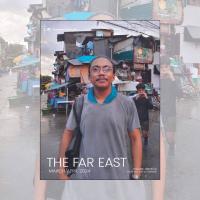
A priest at a Sangam temple chats with Fr Hoare and his group of young people in Fiji. Photo: Fr Frank Hoare SSC
Young people from the island nations of the Pacific have contributed least to planetary destruction. However, they suffer its consequences sooner and with greater severity than those bearing the most responsibility. They can expect massive cyclones to destroy their villages, damage their coastlines and traumatise their people. Many will see crops rot in the wake of floods or shrivel during droughts. Rising sea levels will condemn others to flight as their low-lying islands are submerged. Their cries must be heeded.
In Fiji, our Columban Interreligious Dialogue Desk has been organising sessions for young people from various religions every two months. When we were struck by COVID-19 in March 2020 and then by the Delta variant in March last year, our efforts at interreligious dialogue came to a standstill as we focused on this unknown enemy. Later, the internet service, Zoom, allowed us to resume discussions, albeit remotely.
However, an even more dangerous threat was silently growing - the climate crisis. Carbon dioxide, methane and other gasses belched into the atmosphere by transport, agricultural and industrial machinery was pushing the world’s temperature towards a disastrous three-degree Centigrade rise by the end of the century. Political and industry leaders were coming under pressure to make radical and decisive cuts to carbon emissions and all of us were being called to moderate our lifestyles and live more lightly on the planet.
The youth from the Interreligious Dialogue Desk and leaders from the Catholic Tertiary Association agreed to participate in two webinars to sharpen awareness of what is happening. Our webinars featured a one-hour production from the British Broadcasting Corporation titled, Climate Change: The facts. This was followed up with nine, three-minute videos produced by various faith groups around Fiji highlighting the miracle of nature and aspects of environmental damage.

A group photograph at the Sangam temple. Photo: Fr Frank Hoare SSC
The Arya Samaj Hindus made a strong plug for vegetarianism. The Methodist youth took us on a virtual sightseeing tour through their newly planted garden. Seminarians from the Pacific Regional Seminary highlighted the value of mangrove forests as a protective eco-system. One young Catholic wrote a poem counterpointing each one of the seven days of creation with a parallel example of damage caused by humans. However, the pearl was a beautiful classical dance representing the wonders of creation by a colourfully costumed South Indian woman.
The call to respect and protect God’s creation is common to all religions, making it an ideal cooperation point among religious communities. Various religious perspectives can inspire and challenge us. Religious diversity brings out the magnificence of God’s creation and God’s love for all humanity.
Young people today are facing a frightening future. They will experience the cost of the greed and denial of previous generations. Those who have lived longer have not always shown wisdom. They have abused the earth, the seas and the atmosphere, as well as the flora and fauna for immediate satisfaction and without thought for the destruction of the web of life. We must heed the insights of various religions calling for the protection of life.
Columban Fr Frank Hoare lives and works in Fiji.
Listen to "Religions and climate change"
Related links
- Read more from The Far East - January/February 2022

